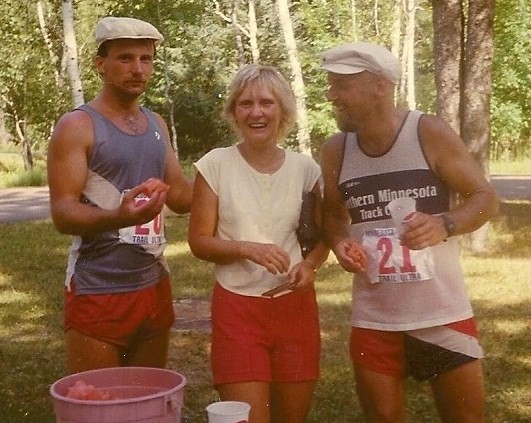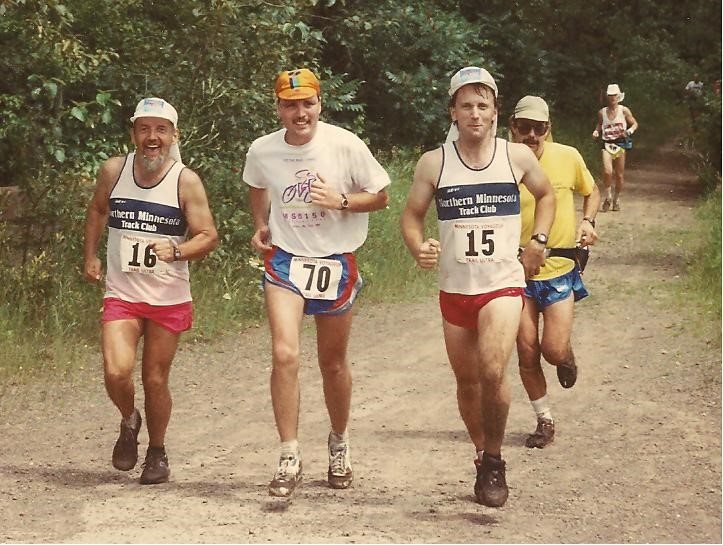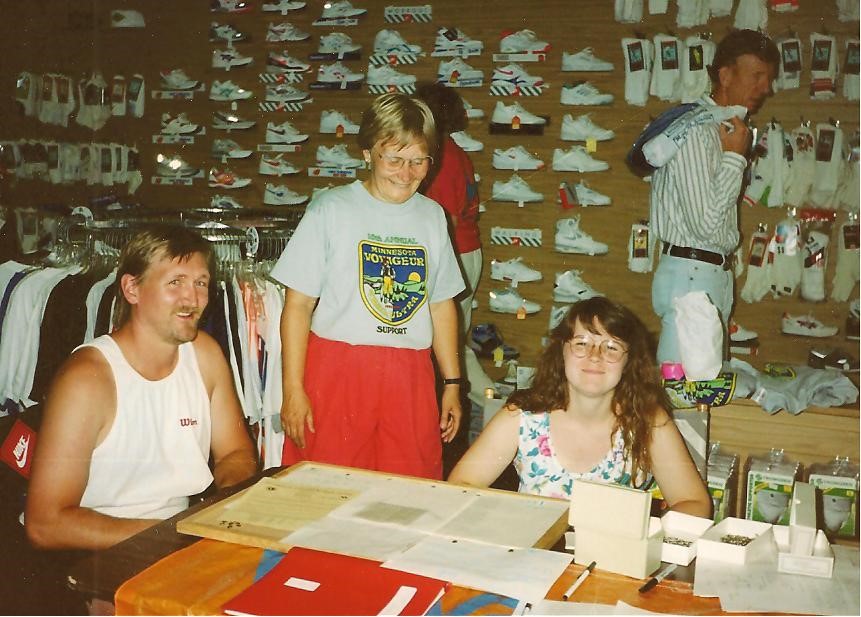Eugene Curnow climbs a steep section of the Minnesota Voyageur Trail Ultramarathon in 1991. It's one of the few known photos of Gene in which he is not chatting with a fellow runner.
Each July, hundreds of runners, supporters, and volunteers come together to celebrate the latest edition of the Eugene Curnow Trail Marathon. Originally called the Half Voyageur, the race now bears the name of its charismatic founder. Gene was often first to identify new faces at trail races and always went out of his way to make everyone feel welcome. He died in 2013 at age 68, just 28 years into his running career. Gene’s wife and former Voyageur race director Barb Curnow, granddaughter Haley Bengston, and several friends shared some of the stories that made Gene a legendary figure in trail running.
Q. In addition to organizing, directing, and volunteering at races, Gene finished more than 200 marathons and ultras. It’s astounding considering when he started running.
Barb Curnow: Gene didn’t start running until age 40 [in 1984]. He had watched Grandma’s Marathon and decided he wanted to run it. This was back when he was still smoking.
Q. Gene quickly took to ultras: the Voyageur 50M, the Ed Fitz 100K, and the Ice Age 50M. He ran the first-ever edition of the Superior 100M in 1991 and later entered its Hall of Fame.
Barb: Gene and two others finished the first five Superior 100s. And then he became the first to finish ten Superior 100s. It took him eleven years. He didn’t start the sixth year [in 1996], but he tried to. He was playing racquetball the Monday before the race and injured himself pretty badly. He was all suited up, ready to run, and went up to register. Harry [Sloan, Superior 100 race director, 1991-1997] took one look at him, took off his number, and said, “Sorry, we need the pins.” Harry did not want to go out on that trail later to dig Gene up.
 From left: Bill Curnow, Barb Curnow, and Gene Curnow pause at an aid station during the 1988 edition of the Minnesota Voyageur.
From left: Bill Curnow, Barb Curnow, and Gene Curnow pause at an aid station during the 1988 edition of the Minnesota Voyageur.
Q. What was it like to be around Gene on race day?
Barb: Gene was very, very social. He talked through every race he ever ran. At one race, Brian Poeppel [Superior 100 race co-director, 1998-2002 & 2004] ended up running with Gene and our son Billy. Brian was still nursing a rib he’d cracked at Voyageur. He couldn’t run faster than Gene, and he didn’t want to run slower! The three of them came through an aid station, and Brian goes: “Don’t they ever stop talking?” The answer was no. Barb [Bengston, Gene and Barb’s daughter] used to get so mad at Gene. She managed one of the Voyageur aid stations. Back then, we not only took care of runners, we took splits of every runner at every aid station. That’s manageable when you’ve got runners trickling through. But by the time Gene would come through, he’d have collected a huge group of 20 people or so, and they would all swarm the aid station at once. Barb stood no chance against Gene’s hordes.
Q. I’m getting a picture of Gene as a gregarious, charismatic guy. Is that accurate?
Barb: For some people! They didn’t have to live with him. He was all of those things. He also never saw a problem. And problems occurred! Guess who took care of the problems?
Q. That’s what makes you a great race director. You took over the Voyageur in 1991. How did that influence Gene’s interest in creating a shorter race on the same trails?
Barb: The year I took over the Voyageur, Gene organized a group run a few weeks before the race. He wanted to take a bunch of people out to see the trail. And he signed me up to be the mobile aid station for everybody. There were enough people to have a fast group and a slow group. So instead of hustling ahead and waiting for the fast group to arrive, I’d also wait for the rest and then hustle twice as hard to get ahead of the fast group. Of course, Gene was having the time of his life showing off the race course. That’s when he decided to create the race. The Half Voyageur Marathon started the following summer, in 1992.
Q. So, he created the Half Voyageur to give his favorite people another chance to hang out?
Barb: The main reason was to give Voyageur volunteers a free race. Everybody else had to pay. The shorter distance made the course more accessible to more people. A lot of our regular Voyageur runners got to bring their significant others out on the trail.
 Gene Curnow (far left) in typical running form, surrounded by running friends.
Gene Curnow (far left) in typical running form, surrounded by running friends.
Q. Was the race always going to be a marathon, 26.2 miles?
Barb: Gene wanted to offer a choice. Either run half of the Voyageur, 25 miles, or run a full marathon distance, 26.2 miles. I helped him realize he’d need to recruit extra volunteers to separate the two groups, and it’s hard enough finding volunteers in the first place. He ended up adding the extra mile to make it a marathon while calling it the Half Voyageur Marathon. Of course, a lot of people thought it was just a half marathon.
Q. In your interview with the Duluth Rundown, you said some newer runners were led to believe it would be a great first-ever marathon for them—nice and easy!
Barb: People would call up Gene and ask if it’s a good first marathon. He always said yes. Because if they could finish this one, the rest would feel easy! Well, after they crossed the finish line, they were ready to kill him.
Q. It is a tough course. In the old days, we had the near-vertical ups and downs of Powerlines. We still get to enjoy the singletrack boulder field of Jarrow’s Beach. Trail maintenance must have been one of the harder tasks on your to-do list.
Barb: Jarrow [Wahman, three-time Voyageur champion] always wanted Gene to move the Half Voyageur one week earlier—three weeks before Voyageur—so he could race them both full out. But that extra week would have meant mowing the course again. The grass in my own lawn was a foot high because Gene was always out mowing the race course with Eddie. Gene got a bad case of Lyme disease three out of four years from age 62 to 66. Somehow Eddie never got it.
Q. It’s clear that volunteering has been a huge part of your lives, as a family.
Barb: Gene’s first Voyageur was 1987. My youngest [Gene, Jr.] and I drove out to see what it was all about. The next year, he dragged my oldest [Billy] into it. I went out and crewed that one, mainly because he had Billy with him. The next year, I captained a Voyageur aid station. The year after that, I captained the aid station with Young Gene’s future wife and her two parents, while the boys ran. By then, Gene was running Ed Fitz, too; before long, I was in charge of the aid stations for Ed Fitz, then Voyageur aid stations, and eventually I was directing the race itself.
 Packet pickup at the 1991 edition of the Minnesota Voyageur, featuring son-in-law Steve Bengtson, Barb Curnow, and daughter Barb Bengtson.
Packet pickup at the 1991 edition of the Minnesota Voyageur, featuring son-in-law Steve Bengtson, Barb Curnow, and daughter Barb Bengtson.
Q. Seems like Gene had a way of convincing other people to get involved.
Barb: Eugene was either running or volunteering. If he was running, he dragged me along, and I was volunteering. I used to work the midnight shift at St. Luke’s, and he’d pick me up in the mornings on the weekends, and push me out, and walk whatever race he was running. Fortunately, by the time I woke up I was done.
Haley Bengston: At the NMTC races, he was always picking up when someone looked at all confused. He’d strike up a conversation: “Hey, how are you doing? Have you done this before? How fast are you?” Always making people feel welcome. It’s just who he was.